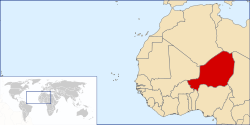
The cuisine of Niger draws on traditional African cuisines. Various spices are used and meals include grilled meat, seasonal vegetables, salads, and various sauces. Meals in Niger usually start with colorful salads made from seasonal vegetables. Moringa leaves are frequently used in salads.[ citation needed ]
Contents
Typical Nigerien meals consist of a starch (rice being the most common) paired with a sauce or stew. The starches eaten most often are millet and rice. Staple foods include millet, rice, cassava, sorghum, maize and beans. [1] [2] Couscous is saved for special occasions. Porridge, wheat dumplings, and beignets are some of Niger's most common snacks. [3] One especially well-known food is jollof rice. [4]
Plant agriculture production in Niger is significantly reliant upon rainfall to provide water for plants, and droughts have adversely affected Niger's agriculture production in the past, threatening the country's domestic food supply. [5]





